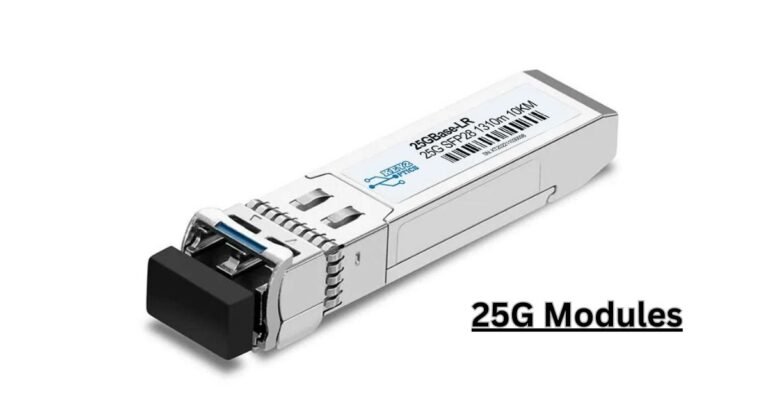Edge computing is rapidly transforming the landscape of data processing and storage, bringing computation closer to the data source. This paradigm shift is essential for improving response times and bandwidth efficiency, especially in an era of burgeoning data generation from IoT devices. Central to this evolution is the integration of high-speed networking components, notably 25G modules. In this article, we will explore the role of 25G modules in edge computing networks, their benefits, use cases, and future trends.
Table of Contents
ToggleUnderstanding Edge Computing
What is Edge Computing?
Edge computing refers to a distributed computing framework that brings computation and data storage closer to the location where it is needed. By processing data at the edge of the network rather than relying solely on centralized cloud services, edge computing minimizes latency, enhances performance, and reduces bandwidth use.
Importance of Edge Computing
With the rise of IoT, connected devices, and real-time data analytics, the demand for efficient data processing has surged. Edge computing addresses this need by facilitating faster data transfer and real-time processing, making it crucial for applications in various sectors, including healthcare, manufacturing, and autonomous vehicles.
The Emergence of 25G Modules
What are 25G Modules?
25G module’s are high-speed networking components designed to support data transmission rates of 25 gigabits per second. These modules typically use optical fiber technology and are available in various form factors, including SFP28 (Small Form-factor Pluggable) and QSFP28 (Quad Small Form-factor Pluggable). They are pivotal in enhancing the capacity and efficiency of modern networks.
Advantages of 25G Modules
- High Throughput: 25G module’s provide a substantial increase in data transfer rates compared to traditional 10G modules, enabling faster data processing at the edge.
- Low Latency: By supporting higher speeds, 25G modules reduce the time it takes for data to travel between devices and servers, which is essential for real-time applications.
- Scalability: As organizations expand their edge computing capabilities, 25G modules offer the scalability needed to accommodate growing data demands without requiring a complete network overhaul.
- Cost-Effectiveness: With the increasing adoption of 25G technology, costs are decreasing, making it a more viable option for organizations looking to upgrade their network infrastructure.
The Role of 25G Modules in Edge Computing Networks
Enhancing Data Processing Speed
In edge computing networks, the ability to process data quickly is critical. 25G module’s significantly enhance data transfer rates, allowing for rapid processing of large data sets generated by IoT devices. This capability is especially beneficial in industries such as:
- Healthcare: Real-time patient monitoring devices can transmit data quickly to central systems, allowing for immediate response in critical situations.
- Manufacturing: Smart factories can analyze data from production lines in real-time, optimizing operations and reducing downtime.
Supporting Real-Time Analytics
As businesses increasingly rely on data analytics for decision-making, the need for real-time insights grows. 25G modules facilitate the rapid transmission of data to analytics platforms, enabling organizations to derive insights and act on them without delay.
Enabling IoT Device Connectivity
The proliferation of IoT devices at the edge of networks requires robust connectivity solutions. 25G modules provide the bandwidth necessary to support numerous devices simultaneously, ensuring seamless data transmission without bottlenecks.
Facilitating Distributed Architectures
Edge computing often employs distributed architectures, where computing resources are spread across various locations. 25G module’s play a crucial role in ensuring efficient communication between these distributed resources, maintaining high performance and reliability.
Use Cases of 25G Modules in Edge Computing
Smart Cities
In smart city initiatives, 25G modules are essential for connecting various sensors and devices. From traffic management systems to environmental monitoring, the high-speed capabilities of 25G technology enable real-time data collection and analysis, leading to improved urban planning and resource management.
Autonomous Vehicles
Autonomous vehicles generate and process vast amounts of data in real time. 25G modules facilitate the high-speed communication required for vehicle-to-everything (V2X) interactions, enhancing safety and efficiency in transportation systems.
Retail Analytics
Retailers are increasingly leveraging edge computing to analyze customer behavior in real time. 25G module’s support the rapid transmission of data from in-store sensors and cameras, allowing for personalized marketing and inventory management.
Future Trends in 25G Modules and Edge Computing
Increased Adoption of AI and Machine Learning
As edge computing evolves, the integration of AI and machine learning will become more prevalent. 25G modules will play a critical role in facilitating the high-speed data transfer needed for training models and making predictions at the edge.
Evolution towards 5G Networks
The rollout of 5G networks will further enhance the capabilities of edge computing. 25G modules will be instrumental in connecting edge devices to 5G infrastructure, enabling faster and more reliable data processing.
Enhanced Security Measures
With increased data transmission speeds, security becomes a critical concern. Future developments in 25G modules will likely focus on incorporating advanced security features to protect data in transit and prevent unauthorized access.
Sustainability Initiatives
As organizations strive for sustainability, the energy efficiency of networking components will gain importance. Future 25G modules may be designed with energy-efficient technologies to minimize their environmental impact while maintaining high performance.
Conclusion
The integration of 25G modules in edge computing networks represents a significant advancement in data processing capabilities. By enhancing data transmission speeds, supporting real-time analytics, and enabling seamless connectivity for IoT devices, 25G technology is essential for the future of edge computing.
As industries continue to embrace digital transformation, the role of 25G modules will only grow more critical. With ongoing advancements and a focus on scalability, security, and sustainability, 25G technology will be at the forefront of driving innovation in edge computing networks. Organizations that invest in this technology will be well-positioned to leverage the benefits of edge computing, ensuring they remain competitive in an increasingly data-driven world.
ALSO READ: Birthday Bonanza: Unlocking Freebies and Surprises

